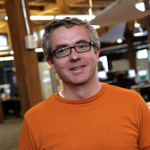QS15 Conference Preview: Jamie Williams on Tracking My Days
Ernesto Ramirez
March 11, 2015
On June 18-20 we’ll be hosting the QS15 Conference & Activate Expo in San Francisco at the beautiful facilities at the Fort Mason Center. This will be a very special year with two days of inspiring talks, demos, and discussion with your fellow self-trackers and toolmakers, plus a third day dedicated to the Activate public expo. As we start to fill out our program we’ll be highlighting speakers, discussion leaders, sponsors, and attendees here.
 Jamie Williams has been involved with QS for a few years, giving his first show&tell talk at the Chicago QS group in Dec. 2012, and later, after moving to St. Louis, he became a co-organizer of the St. Louis QS group. In the fall of 2014 he gave a fantastic show&tell on exploring his Fitbit data. His background in software engineering and data visualization has a deep influence on his interests in Quantified Self and self-tracking.
Jamie Williams has been involved with QS for a few years, giving his first show&tell talk at the Chicago QS group in Dec. 2012, and later, after moving to St. Louis, he became a co-organizer of the St. Louis QS group. In the fall of 2014 he gave a fantastic show&tell on exploring his Fitbit data. His background in software engineering and data visualization has a deep influence on his interests in Quantified Self and self-tracking.
At the QS15 Conference Jamie will sharing his long-standing project to automate the process of continuously tracking what he’s up to during the day. He started out several years ago by building an iPhone app with a UX optimized for continuous tracking, but after using it for a week he found that manual tracking was too tedious and intrusive to be a sustainable solution.
Since then, technology has evolved to the point where it should be possible to automate this tracking using various apps, devices and sensors, whose data can be aggregated together to form a correlated timeline of how I spend my time each day.
A visualization of daily activity data taken with a prototype iPhone app Jamie built.
We’re excited to have Jamie joining us at QS15 and asked him a few questions about himself and what he’s looking forward to at the conference.
QS: What is your favorite self-tracking tool (device, service, app, etc)?
Jamie: I use several apps and devices, but I guess the one that seems most useful at the moment is the Fitbit Charge HR. I particularly like the automated sleep tracking.
QS: What are you most looking forward to at the conference?
Jamie: I’m looking forward to networking with other self quantifiers who are interested in activity/time tracking in particular, and hopefully finding potential avenues for collaboration. I’m also looking forward to learning about new tools that people are building.
QS: What should people come talk to you about at the conference (what are you interests and expertise)?
Jamie: I recently pivoted my career into the healthcare space with a position as a data visualization engineer at a large health system. Before that I was an iOS software engineer. One of the difficult problems in QS is how to aggregate the growing body of data streams to build a unified and coherent story that we can use to gain insight about our lives. I’d love to hear how others are approaching this.
QS: What tools, devices, or apps do you want to see at the conference?
Jamie: I’m really interested in seeing the next generation of biometric tracking tools, for example, blood screening. I’m also curious to learn of any projects centered around information radiators/dashboards for personal QS tracking.
QS: What topic do you think that Quantified Self community is not talking enough about?
Jamie: One of the recurring challenges in this space for any kind of tool or technique is: how to find the sweet spot balance between automated tracking and user engagement? Tracking diet is a good example: I don’t do it because it requires too much manual effort, but would love to have the data. Tracking my financial transactions, on the other hand, is completely automated, which is good, but I have almost no daily engagement with that data. The really hard problem is to find a way to automate data tracking while at the same time presenting the info to the user in a timely and compelling way that can impact their behavior.
Jamie’s session is just one of the many hands-on, up-to-date, expertly moderated sessions we’re planning for the QS15 Global Conference and Exposition.



